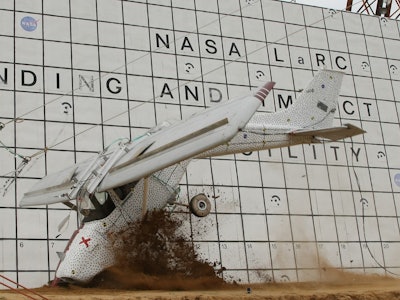Why NASA Deliberately Crashes Perfectly Good Airplanes
‘You really want to buy my airplane and destroy it?’

They call it “the gantry.” This metal behemoth is a 24-story tall, red and white eight-legged structure that towers above Hampton, Virginia, and NASA uses it to slam planes into the ground.
After the gantry’s completion, in 1965, astronauts Buzz Aldrin and Neil Armstrong visited the colossal assembly at the NASA Langley Research Center, because it was designed for moon lander training, where the gravity is just one-sixth that of Earth. Here, during the 1960’s race the moon, engineers attached a mock lunar lander to a suspension system that removed over 80 percent of the lander’s weight, giving Aldrin and Armstrong the chance to land in moon-like conditions.
The ambitious (and pricey) moon expeditions ended in 1973, leaving the gantry abandoned and purposeless — though not for long. While the gantry’s original intention was to help astronauts avoid crash landings, it was repurposed to deliberately pummel aircraft into ground, to test a plane’s crashworthiness. (The gantry is still used for other impact-testing too, like NASA’s next generation Orion capsule.) The most recent plane crashes in 2015, however, were not meant to assess the planes’ ability to withstand deadly impacts, but to test NASA’s new emergency locator beacon technologies, which intend to make searching for crashed planes and any potential survivors aboard substantially more precise.
The view from below the gantry. NASA calls this pool the Hydro-Impact Basin, which allows engineers to plop things like the Orion space capsule (which will bring humans back from Mars) into the water. In reality, this Mars capsule will land in the ocean, sometime in the 2030s.
If a plane goes down today, an emergency beacon will give rescuers a one and a quarter-mile radius of where the plane might be, at best. NASA plans to reduce this number to just over 100 yards. But this effort becomes moot if the beacon is destroyed among the twisted metal and snapped wings.
“We wanted to stress the system as badly as we could, where a human being would be put in a perilous situation and they may or may not be dead,” Chad Stimson, the Emergency Locator Transmitter Survivability and Reliability project manager, told Inverse.
Stimson was tasked with engineering crashes where the plane’s occupants were possibly alive and definitely injured, but first he needed planes — good planes. “I couldn’t get a junker,” says Stimpson. “It had to be an aircraft that could have been flying when crashed.”
He decided on three Cessna 172s for three separate crashing events, one of which came from a local fisher spotter who flew around Chesapeake Bay, spying on schools of fish. The fish spotter, Bill Corbett, asked Stimpson, incredulously, “You really want to buy my airplane and destroy it?”
Indeed, NASA was dead serious.
The crashes themselves were swift and debris-ridden, but the preparation meticulous. Engineers buckled up crash-test dummies and fitted them with accelerometers — to ensure that the beacons were pushed to the limits of what a human body might be subject to and still survive. Additionally, each crash scenario required dropping the plane from a different angle — nose-up, nose-down, and flat.
When the planes finally dropped from the gantry, from between 80 to 100 feet up, Stimson heard the wind whistling through the aircraft. “It was sort of surreal to watch — just broken glass and twisted metal,” he said.
Ouch.
Following the metallic turmoil, NASA engineers observed some immediate problems — and solutions. Of note, they found that both the beacon and its antenna should be located in same frame or compartment of the plane. If separated, perhaps to stow the beacon in more protected part of the plane, the cable could be easily ripped apart, rendering the system useless, as the antenna must communicate with satellites.
NASA isn’t just improving locator beacons, it’s overhauling the planet’s entire 1970s-era search and rescue system, which includes new satellites and ground receiving stations, Lisa Mazzuca, the Search and Rescue mission manager at NASA’s Goddard Space Flight Center, told Inverse. In concert with beacons that can survive harsh impacts with ground, a modern constellation of globally-supported satellites will receive emergency signals — whether from a plane, ship, or hiker — almost instantaneously. At least six satellites will be ready to pick up each distress communication. “It’s a game changer,” says Mazzuca.
The transition to the new system is nearing completion, and in the next couple of years NASA, in collaboration over 40 nations, will begin giving manufacturers guidance on how modern beacons will be able to communicate with the dozens of search and rescue satellites orbiting Earth, ultimately giving rescuers a dramatically improved idea of where a crumpled, flattened plane might be hiding.
Buckle up.